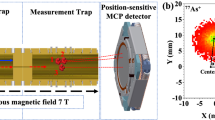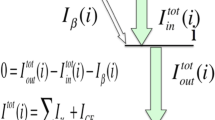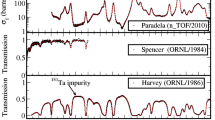Summary
Measurements of the residue cross-sections for the32S+24,25,26Mg reactions have been performed in the rangeE lab=(140÷175)MeV, to study the amount of limitation undergone by fusion in regime II. Residual nuclei have been identified by means of the in beam γ-spectroscopy method. Comparison of evaporation residue cross-sections with statistical calculations shows an average overall agreement although large discrepancies are found for some outgoing channels. Fusion excitation functions confirm previous evidences on the onset of regime II atE lab∼145 MeV. This exhibits considerable limitations to the fusion process. Considering the whole set of the data, the barrier penetration model reproduces the lowenergy behaviour with a slight overestimation of experimental results. Values ofl cr=35▄ for the angular momentum andR cr≈(6÷6.2) fm for the critical distance are respectively found. The surface friction model gives very good agreement in the low-energy part, but its calculations are larger than the experimental values in regime II. Some evidence is reported in the literature which could indicate that a fusion-fission process is mainly responsible for the deficit on the evaporation residue cross-section.
Riassunto
Il processo di fusione tra32S e gli isotopi del magnesio,24Mg,25Mg e26Mg è stato studiato nel regime II per energie comprese nell’intervalloE lab≈(140÷175) Mev. Le misure sono state effettuate identificando i residui di evaporazione mediante rivelazione dei gamma descreti caratteristici. Il confronto delle distribuzioni inZ eA dei residui con i calcoli di evaporazione (programma CASCADE) mostra un generale accordo. Esso però viene sensibilmente migliorato allorché si tiene conto della deformazione del nucleo composto nel calcolo dei coefficienti di trasmissione delle particelle evaporate. Le funzioni di eccitazione confermano l’inizio del regime II all’energia di ∼-145 MeV e mostrano notevoli limitazioni al processo di fusione. Il modello a penetrazione di barriera ne riproduce l’andamento anche se sovrastima leggermente i dati sperimentali. Una distanza criticaR cr≈(6÷6.2) fm e un momento angolare criticol cr=35 ħ sono determinati in corrispondenza della scomparsa del «pocket» nel potenziale. Anche il modello a frizione di superficie (surface friction model) che riproduce bene i dati sperimentali a bassa energia li sovrastima alle energie del regime II. Da alcuni dati riportati in letterature, relativi al sistema32S+24Mg aE lab=141.8 MeV, risulta che il processo di fusione-fissione dia un contributo apprezzabile alla sezione d’urto di reazione. Perciò esso potrebbe essere responsabile della notevole riduzione della fusione quale risulta nel presente lavoro. Sarebbe quindi interessante indagare sulla presenza di questi contributi e di altri analoghi, (fast fission, etc.) alle energie piú alte.
Резюме
Проведены измерения остаточных поперечных сечений для реакций32S+24,25,26Mg в области энергийE лаб=(140÷175)МэВ, чтобы исследовать величину ограничения, накладываемого синтезом в режиме П. Остаточные ядра идентифицируются с помощью метода γ-спектроскопии пучка. Сравнение остаточных поперечных сечений со статистическими вычислениями обнаруживает согласие в среднем, хотя обнаружены большие различия для некоторых выходящих каналов. функции возбуждения синтеза подтверждают предыдущие результаты по возникновению режима П приE лаб∼145 МэВ. Обнаружены значительные ограничения на процесс синтеза. Рассматривая полную систему данных, модель проникновения барьера воспроизводит поведение при низких энергиях с некоторой переоценкой экспериментальных результатов. Соответственно получаются величиныl kp=35ħ для углового момента иR kp≈(6÷6.2) фм для критического расстояния. Модель поверхностного трения дает хоромее согласие в области низких энергий, но полученные с ее помощью результаты оказываются больше, чем экспериментальные величины в режиме П. Из опубликованных в литературе данных следует, что процесс синтеза-деления, в основном, ответственен за дефицит остаточного поперечного сечения.
Similar content being viewed by others
References
B. DiCenzo, J. F. Petersen andR. R. Betts:Phys. Rev. C,23, 2561 (1981).
D. F. Geesaman, C. N. Davids, W. Henning, D. G. Kovar, K. E. Rehm, J. P. Schiffer, S. L. Tabor andF. W. Prosser jr.:Phys. Rev. C,18, 184 (1978);E. Vigdor, D. G. Kovar, P. Sperr, J. Mahong, A. Menchaca-Rocha, C. Olmer andM. S. Zisman:Phys. Rev. C,20, 2147 (1979).
F. Puhlhofer, W. F. W. Schneider, F. Bush, J. Barrette, P. Braun-Munzinger, C. K. Gelbke andH. E. Wegner:Phys. Rev. C,16, 1010 (1977).
H. Lehr, W. Bohne, K. Grabisch, H. Morgenstern andW. von Oertzen:Nucl. Phys. A,415, 149 (1984).
G. Rosner, J. Pochodzalla, B. Heck, G. Hlawatsch, A. Miczaika, H. J. Rabe, R. Butsch, B. Kolb andB. Sedelmeyer:Phys. Lett. B,150, 87 (1985).
Y. Nagashima, J. Schimizu, T. Nakagawa, Y. Fukuchi, W. Yokota, K. Furuno, M. Yamanouchi, S. M. Lee, N. X. Dai andT. Mikumo:Phys. Rev. C,33, 176 (1986).
H. Dumont, B. Delaunay, J. Delaunay, D. M. De Castro Rizzo, M. Brondi, P. Cuzzocrea, A. D’Onofrio, R. Moro, M. Romano andF. Terrasi:Nucl. Phys. A,435, 301 (1985).
D. Glas andU. Mosel:Nucl. Phys. A,237, 429 (1975).
C. Ngo: inProceedings of the International Conference on Nuclear Physics, Florence, 1983 Vol.2, edited byP. Blasi andR. A. Ricci, (Editrice Compositori, Bologna, 1983), p. 321.
J. R. Birkelund, L. E. Tubbs, J. R. Huizenga, J. N. De andD. Sperber:Phys. Rep.,56, 107 (1979).
P. Frobrich:Phys. Rev.,116, 337 (1984).
S. M. Lee, T. Matsuse andA. Arima:Phys. Rev. Lett.,45, 165 (1980).
T. Matsuse, A. Arima andS. M. Lee:Phys. Rev. C,26, 2338 (1982).
R. Vandenbosch:Phys. Lett. B,87, 183 (1979).
F. Saint Laurent, M. Conjeaud, S. Harar, J. M. Loiseaux, J. Menet andJ. B. Viano:Nucl. Phys. A,327, 517 (1979).
R. Bass:Phys. Lett. B,47, 139 (1973).
Sl. Cavallaro, Luo Yi Xiao andM. L. Sperduto:Phys. Rev. C,32, 1584 (1985).
S. Cavallaro, Yin Shu Zhi, G. Prete andG. Viesti:Phys. Rev. C,40, 98 (1989).
S. Cavallaro andJ. Delaunay: Commissariat à l’Energie Atomique, Report CEA-N-2385 (1984), p. 33;S. Cavallaro et al.: unpublished.
K. Alder, A. Bohr, T. Hnus, B. Mottelson andA. Whinther:Rev. Mod. Phys.,28, 432 (1956).
A. Moroni, I. Iori, Li Zu Yu, G. Prete, G. Viesti, F. Gramegna andA. Dainelli:Nucl. Instrum. Methods Phys. Res.,225, 57 (1984).
F. Puhlhofer:Nucl. Phys. A,280, 267 (1977).
D. Wilmore andP. E. Hodgson:Nucl. Phys.,55, 462 (1961);P. E. Hodgson:Annu. Rev. Nucl. Sci.,17, 1 (1967).
F. G. Perey:Phys. Rev.,131, 745 (1963).
J. R. Huizenga andG. Igo:Nucl. Phys. A,29, 462 (1961).
F. Bertrand, M. Martinot andN. Verges: in IAEA Report IAEA-SM-170/60, Vol.2 (1973).
W. Dilg, W. Schantl, H. Vonach andM. Uhl:Nucl. Phys. A,217, 269 (1973).
J. Gomez Del Campo andR. G. Stokstad:Description and use of the Montecarlo code Lilita, ORNL/TM-7295 (1981); andLilita 1, version of the code modified byA. D’Onofrio andJ. Gomez Del Campo (Saclay, 1986).
J. Gomez Del Campo, R. G. Stokstad, J. A. Biggerstaff, R. A. Dayras, A. H. Snell andP. H. Stelson:Phys. Rev. C,19, 2170 (1979).
H. Morgenstern, W. Bohne, K. Grabisch, D. Kovar andH. Lehr:Phys. Rev. Lett. B,113, 463 (1982).
J. Wilczynski andK. Siwek-Wilczynska:Phys. Lett. B,55, 270 (1975).
P. Frobrich: private communication.
S. J. Sanders, D. G. Kovar, B. B. Back, C. Beck, B. K. Dichter, D. Henderson, R. V. F. Janssens, J. G. Keller, S. Kaufman, T. F. Wang, B. Wilkins andF. Vindebaek:Phys. Rev. Lett.,59, 2856 (1987).
A. J. Sierk:Phys. Rev. C,33, 2039 (1986).
Author information
Authors and Affiliations
Additional information
Перевебено редакцией.
Rights and permissions
About this article
Cite this article
Cavallaro, S., Sperduto, M.L. Regime II of fusion process in the collision of32S with magnesium isotopes. Nuov Cim A 103, 429–446 (1990). https://doi.org/10.1007/BF02790025
Received:
Published:
Issue Date:
DOI: https://doi.org/10.1007/BF02790025




